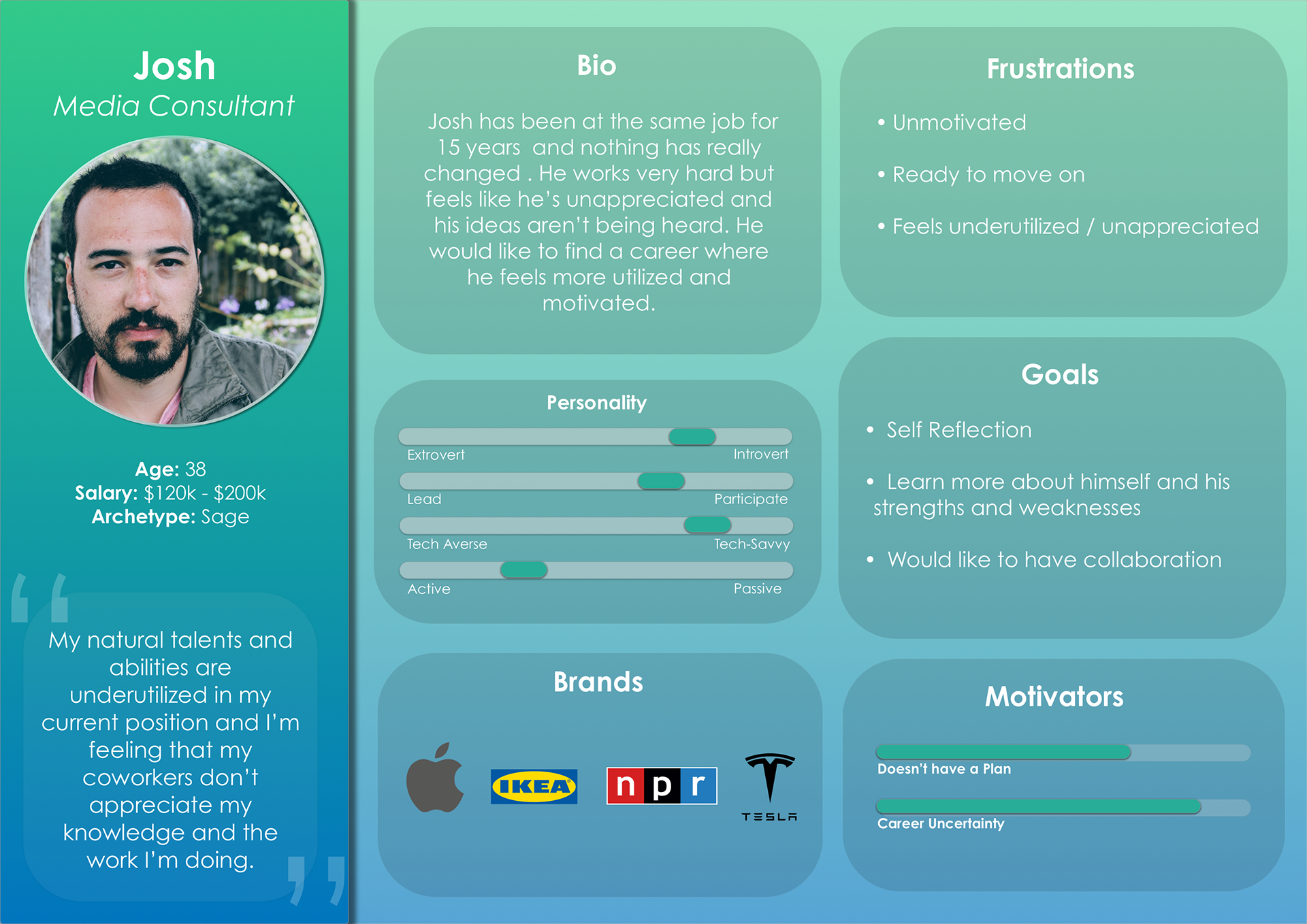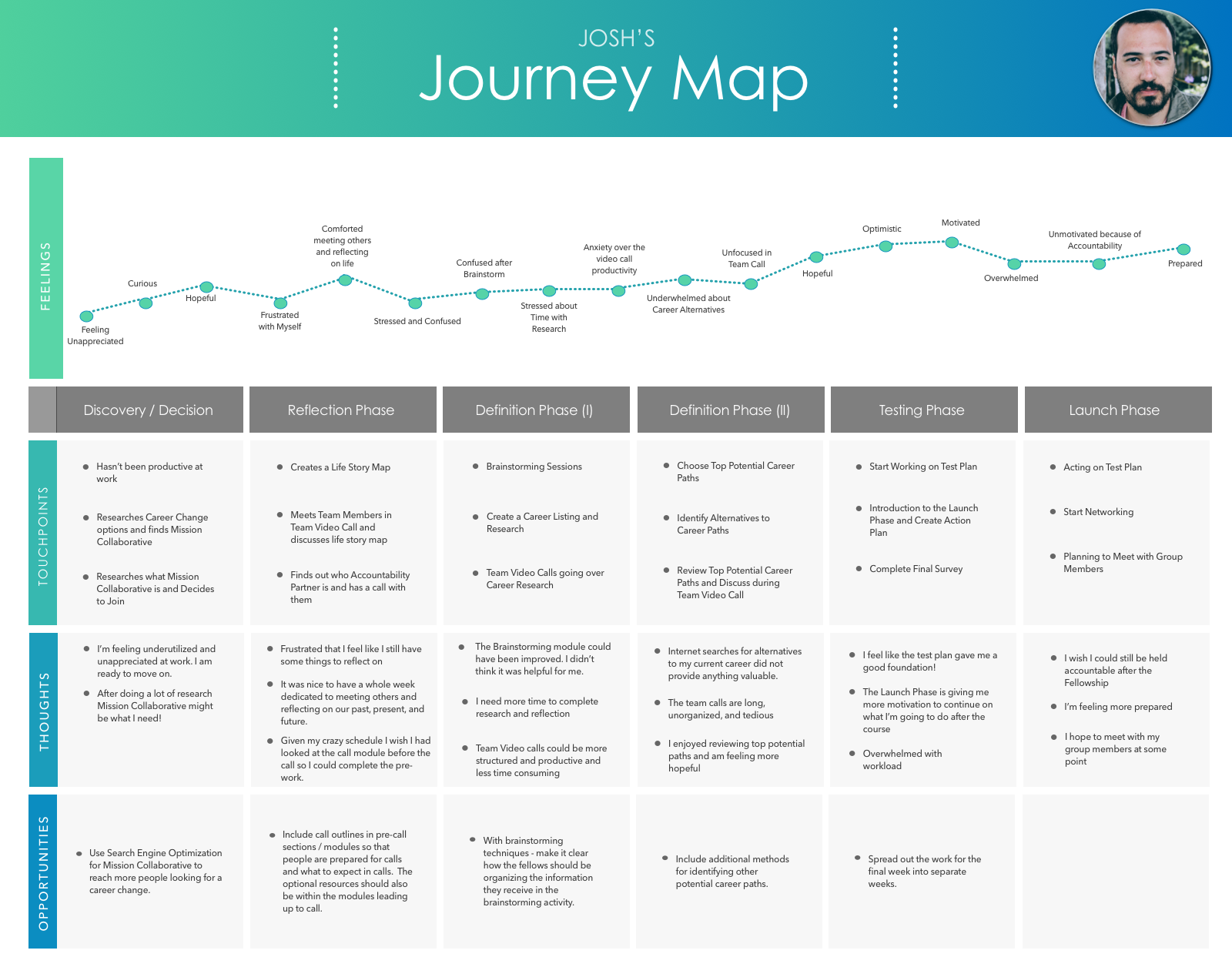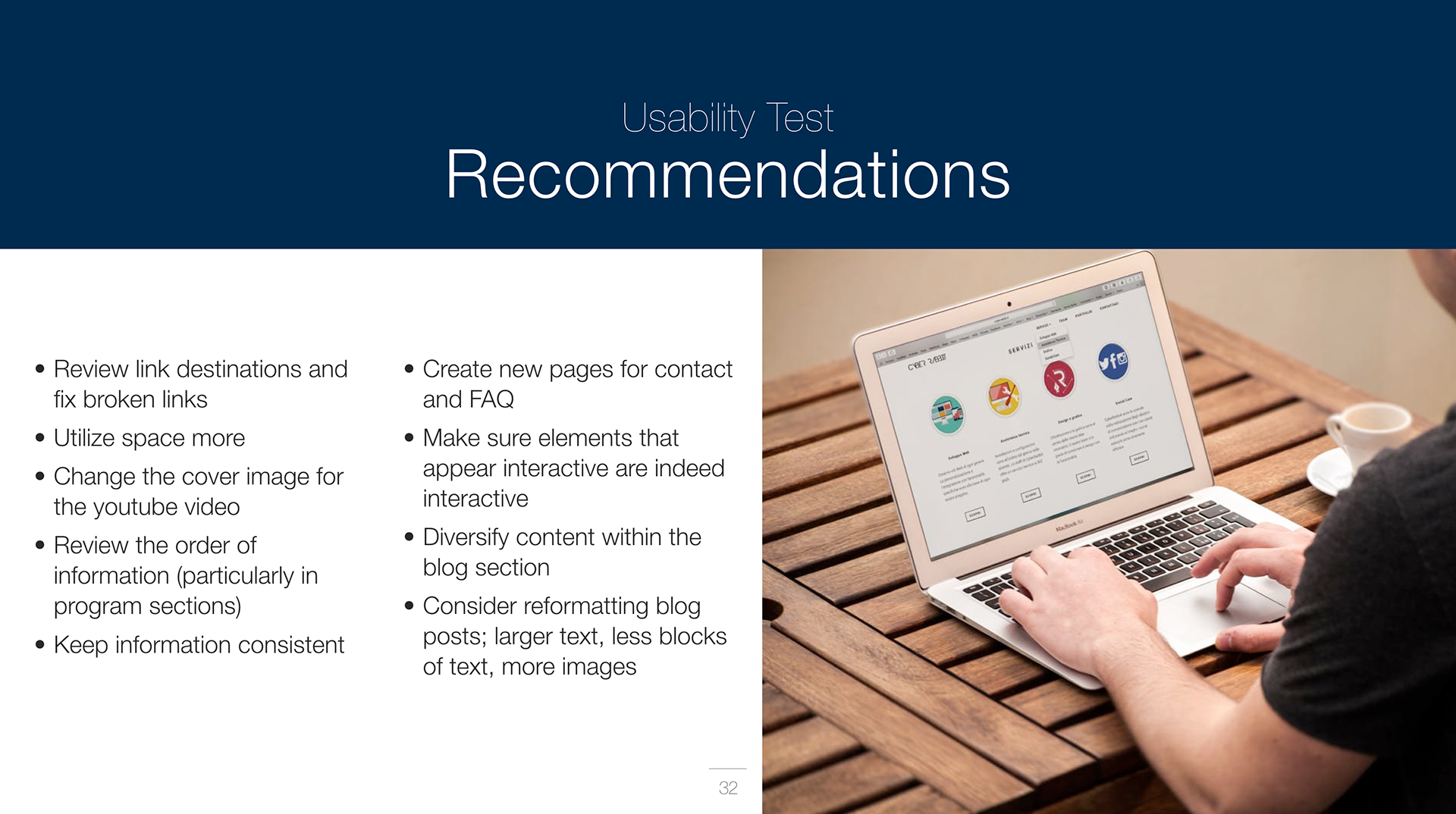______________
Design Challenge
This project is concerned with service design, usability and accessibility. The scope of the work is based around assessing the customer experience and providing an assessment along with recommendations on improving both the high-level journey as well as specific components of the customer experience.
Client
Mission Collaborative runs career change workshops and programs for working professionals. Regardless of background or age, our proven Career Design Process will give the clarity and plan you need to design a career you really love.
Deliverables
● Key findings from user research and analysis of UVA Fellowship data including:
Flows and content mapped week-by-week with suggestions to more easily capture feedback; 3-5 personas, with journey maps for each, a service blueprint and scenarios as applicable; Recommendations for feedback collection and interaction/behavior data collection as way to improve the experience and grow business
● Usability test results and compliance assessment including:
Overview of accessibility and statement summarizing current state for external communication; WCAG 2.0 compliance audit; Key recommendations for layout and content improvement with next steps
● Organized set of artifacts and deliverables with documentation, and a final presentation to the client which summarizes the user experience work
User Need
Mission Collaborative is striving for clarity, to teach people a process they can use for life, build lasting community, expose participants to new ideas, give career changers a boost of emotional energy to help them get unstuck. They are looking to understand and optimize their service experience and assess the current state of their career change experience.
Constraints/Role
● Timeline - Three Weeks
● Team - 3 members
● Role - User Research, Service Design, Visual Design
Tools Used
Sketch App | Adobe XD | Microsoft Excel | Keynote
Research
Data Analysis
Mission Collaborative provided us with data from 147 previous students and UVA Alumni who had already gone through through the course and provided feedback on service.
Screener Survey
The screener survey was used to learn more about job experiences, habits, and behaviors. By presenting a set of demographic and behavior questions, we were able to evoke discussion with potentially interested candidates of the client’s product.
We received over 80 responses to the survey and with these responses we decided on 15 users that we could interview, both on the phone and in-person. The interviews resulted in a lot of useful information that we used to help us empathize with a user going through a program like Mission Collaborative.
Survey and Interview Takeaways
83 Survey Responses | 15 User Interviews
● Fear, financial stability, and career uncertainty is what is holding people back from not going ahead with their career change
● Needing direction, clarity, and self reflection were the top reasons that the person was coming to Mission Collaborative
● The most prominent frustrations at current jobs included feeling unfulfilled, lack of variety at current job, and feeling underutilized and unappreciated
We combined the interview data with UVA Alumni Data we received from Mission Collaborative and started synthesizing. The alumni data collected included feedback from the "Fellows" regarding feelings and experiences before they came to Mission Collaborative, how they felt throughout the one month program and their ups and downs through each teaching module. With this data we first made affinity maps to find trends in user expectations leading up to Mission Collaborative and to understand who the users are to ultimately help to build personas.
Analysis
Personas



Using affinity mapping we found out the most prevalent frustrations, goals, motivators, etc. of the users going into Mission Collaborative as explained in the takeaways above.
While my team and I were synthesizing both the interview data and UVA Alumni data, I designed a persona layout on Sketch that my team and I thought would best show these goals, motivators, frustrations, etc.
Analysis of UVA Data
After creating the personas we started to synthesize more of the UVA Data to help map out what each of these users’ experiences would be like while completing the Online Fellowship at Mission Collaborative.


Journey Maps






We dove deeper into the data after analyzing the data and also did more affinity mapping to help us synthesize the data. With this we were able to come up with some major pain points for the users and include them on our journey maps for each persona depending on the type of person they were.
With these pain points we realized a few opportunities Mission Collaborative has in making some of their modules, the teams, collaboration, etc. better for the user experience. These are shown in the chart above.
Opportunities
● Improve the Collaborative aspect - both with the accountability partner as well as the team partners
● Many users were overwhelmed with the amount of work especially in week four. Spread out some of the time into an extra week or over the course of the whole bootcamp in order to lessen the work.
● Some groups needed more moderation during their video calls
● Provide more information to the Fellows before they have video calls to show them exactly what they need during the call
Findings
We all did some secondary research and zoned in on the collaboration aspect and how that could be better. Shown below are just a few of the quotes from the UVA data showing how the users felt about collaboration and it needing to be improved.
We found some great articles on team collaboration from the Harvard Business Review, Google Aristotle, Aurora University, and USAID.
Recommendations
Social Time
● Icebreakers
● Virtual Coffee Meetups
Catering Towards Participation Styles
● 1-on-1 Meetups following Group Meetings
● Encourage written engagement
Preparedness
● Clear expectations before meetings
Moderation
● Equal sharing
● Awareness of facial cues
● Making sure everyone stays focused
Usability Testing
Mission Collaborative asked us to also help them with their website. We conducted Five Usability Tests on Mission Collaborative’s Website in order to:
● Gather insights on some problems users may have while trying to navigate the interface
● Identify bugs on the website
● Gather insights about needed features
● Understand the pain points of the user while navigating Mission Collaborative’s website




Accessibility
Last but not least, we tested the Accessibility of Mission Collaborative’s website. We completed the test using the Google Chrome Extension “SiteImprove” to see where we needed to focus. We then went over the WCAG 2.0 checklist using the information provided by SiteImprove along with our findings of the website.
Overall the Accessibility was really great. A few small changes needed to be done in order to at least get past the “A” Guideline Requirements were:
● Fix contrast ratio on each page; specifically menu bar.
● Fix tabbing sequence to be consistent
● Image links need alternative text
Takeaways
Collaboration is key to Mission Collaboratives success. Users are expected to grow and learn through these shared experiences, therefore thinking of ways to optimize collaboration is crucial to Mission Collaboratives success and furthermore the success of its users in reaching their career and life dreams.
Given communication is a proven indicator of team cohesion and success, developing a larger focus on factors that are contributing to strong communication for the program as a whole should become a fundamental part of the process.
What I learned from this three week project was how helpful Personas and Journey Maps are, especially in this type of Service Design Process where you are looking at ways to improve the User Experience of a service. In the future I will definitely continue using Personas when needed to help me empathize with a user of the product, service, design, etc.




